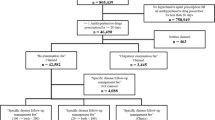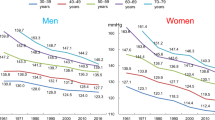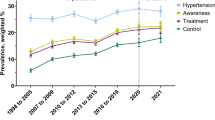Abstract
We investigated the prevalence of hypertensive patients and treated hypertensive patients using a Japanese nationwide administrative claims database. We analyzed national database data from 2014, including all claims data, provided by the Ministry of Health, Labour and Welfare of Japan. Hypertensive diseases were identified using Japanese standardized disease codes. Among hypertensive patients, treated hypertensive patients were defined by the prescription of any antihypertensive medication, identified using national health insurance price listing codes. We calculated and compared the number and age-adjusted prevalence of hypertensive patients and treated hypertensive patients by prefecture and the proportion of these patients by the size of medical facilities. In 2014, approximately 27 million Japanese people were identified as hypertensive, among which 89.6% were treated. The age-adjusted prevalence of hypertensive patients (per 100,000 persons) among women and men was 21,414 and 21,084, respectively. The age-adjusted prevalence of treated hypertensive patients (per 100,000 persons) among women and men was 19,118 and 18,974, respectively. While the prevalence of hypertensive and treated hypertensive patients varied geographically, the prevalence remained similar between the sexes. Approximately 59% of hypertensive patients visited clinics (0 to 19 beds) in Japan. In Japan, 27 million people were diagnosed with hypertensive diseases, and approximately 90% of these patients were treated with any antihypertensive medication in 2014. The distribution of hypertensive patients varied geographically throughout Japan.
This is a preview of subscription content, access via your institution
Access options
Subscribe to this journal
Receive 12 print issues and online access
$259.00 per year
only $21.58 per issue
Buy this article
- Purchase on Springer Link
- Instant access to full article PDF
Prices may be subject to local taxes which are calculated during checkout





Similar content being viewed by others
References
Arai H, Ouchi Y, Yokode M, Ito H, Uematsu H, Eto F, et al. Toward the realization of a better aged society: Messages from gerontology and geriatrics. Geriatr Gerontol Int. 2012;12:16–22.
World Health Organization. World report on ageing and health 2015. http://www.who.int/ageing/events/world-report-2015-launch/en/.). World Health Organization 2015.
Ikeda N, Saito E, Kondo N, Inoue M, Ikeda S, Satoh T, et al. What has made the population of Japan healthy? Lancet. 2011;378:1094–105.
Shibuya K, Hashimoto H, Ikegami N, Nishi A, Tanimoto T, Miyata H, et al. Future of Japan’s system of good health at low cost with equity: beyond universal coverage. Lancet. 2011;378:1265–73.
Miura K. Epidemiology and prevention of hypertension in Japanese: how could Japan get longevity? EPMA J. 2011;2:59–64.
Buford TW. Hypertension and aging. Ageing Res Rev. 2016;26:96–111.
Chow CK, Teo KK, Rangarajan S, Islam S, Gupta R, Avezum A, et al. Prevalence, awareness, treatment, and control of hypertension in rural and urban communities in high-, middle-, and low-income countries. JAMA. 2013;310:959–68.
Umemura S, Arima H, Arima S, Asayama K, Dohi Y, Hirooka Y, et al. The Japanese Society of Hypertension Guidelines for the Management of Hypertension (JSH 2019). Hypertens Res: Off J Jpn Soc Hypertens. 2019;42:1235–481.
Miura K, Nagai M, Ohkubo T. Epidemiology of hypertension in Japan: where are we now? Circulation J: Off J Jpn Circulation Soc. 2013;77:2226–31.
Hisamatsu T, Segawa H, Kadota A, Ohkubo T, Arima H, Miura K Epidemiology of hypertension in Japan: beyond the new 2019 Japanese guidelines. Hypertens Res: Off J Jpn Soc Hypertens. 2020.(e-pub ahead of print 2020/07/09; https://doi.org/10.1038/s41440-020-0508-z).
Nakamura K, Okamura T, Miura K, Okayama A. Hypertension and medical expenditure in the Japanese population: Review of prospective studies. World J Cardiol. 2014;6:531–8.
Mills KT, Stefanescu A, He J. The global epidemiology of hypertension. Nat Rev Nephrol. 2020;16:223–37.
Perkovic V, Huxley R, Wu Y, Prabhakaran D, MacMahon S. The burden of blood pressure-related disease: A neglected priority for global health. Hypertension 2007;50:991–7.
Fujimori K. Current status and issues of the national database. Iryo Shakai. 2016;26:15–24.
Matsuda S, Fujimori K. The claim database in Japan. Asian Pac J Dis Manag. 2014;6:55–59.
Ministry of Health Labour and Welfare. https://www.mhlw.go.jp/file/06-Seisakujouhou-12400000-Hokenkyoku/0000117728.pdf. Accessed 2nd February 2020.
Ikegami N, Yoo B-K, Hashimoto H, Matsumoto M, Ogata H, Babazono A, et al. Japanese universal health coverage: evolution, achievements, and challenges. Lancet. 2011;378:1106–15.
Statistics Bureau of Japan. Table10. Population by Age (5-Year Age Group) and Sex for Prefectures -Total population, October 1, 2014. https://www.e-stat.go.jp/stat-search/files?page=1&layout=datalist&toukei=00200524&tstat=000000090001&cycle=7&year=20140&month=0&tclass1=000001011679&stat_infid=000029026259%2020%3A52%202020%2F02%2F02. Accessed 6th January 2020.
Ministry of Health Labour and Welfare. Types of Medical Institutions. https://www.mhlw.go.jp/english/wp/wp-hw2/part2/p3_0006.pdf. Accessed 25th June 2020.
Sato Y, Nomura H, Ito S, Kimotsuki K, Tahara Y, Watanabe S. Strategies for Using Open Innovation to Establish a Next-generation NDB Data Research Platform What Sort of System is Right for the Era of Big Data? https://www.hitachi.com/rev/archive/2019/r2019_04/extra/index.html. Accessed 25th June 2020.
Goda K, Hayamizu Y, Yamada H, Kitsuregawa M. Out-of-order execution of database queries. Proc VLDB Endow. 2020;13:3489–501.
Sato J, Yamada H, Goda K, Kitsuregawa M, Mitsutake N. Enabling patient traceability using anonymized personal identifiers in Japanese universal health insurance claims database. AMIA Jt Summits Transl Sci Proc AMIA Jt Summits Transl Sci. 2019;2019:345–52.
Funatogawa I, Funatogawa T, Nakao M, Karita K, Yano E. Changes in body mass index by birth cohort in Japanese adults: Results from the National Nutrition Survey of Japan 1956-2005. Int J Epidemiol. 2009;38:83–92.
Nakamura K, Okamura T, Hayakawa T, Hozawa A, Kadowaki T, Murakami Y, et al. The proportion of individuals with obesity-induced hypertension among total hypertensives in a general Japanese population: NIPPON DATA80, 90. Eur J Epidemiol. 2007;22:691–8.
Inoue H, Suzuki T, Kojima M, Inoshita E, Lee J, Tanaka S. et al. Factors related to life expectancy in prefectures: An ecological study using the National. Database. [Nihon koshu eisei zasshi]. Jpn J Public Health. 2019;66:370–7.
Statistics Bureau of Japan. Population Census / 2015 Population Census / Basic Complete Tabulation on Population and Households Japan. https://www.e-stat.go.jp/en/stat-search/files?page=1&layout=datalist&toukei=00200521&tstat=000001080615&cycle=0&tclass1=000001089055&tclass2=000001089056&stat_infid=000031473213. Accessed 16th September 2020.
Statistics Bureau of Japan. FINAL REPORT OF THE 2015 POPULATION CENSUS POPULATION AND HOUSEHOLDS OF JAPAN. http://www.stat.go.jp/data/kokusei/2015/final.html. Accessed 23rd February 2021.
Ueshima H, Sekikawa A, Miura K, Turin TC, Takashima N, Kita Y, et al. Cardiovascular disease and risk factors in Asia: A selected review. Circulation 2008;118:2702–9.
Group ICR. Intersalt: an international study of electrolyte excretion and blood pressure. Results for 24 h urinary sodium and potassium excretion. Intersalt Cooperative Research Group. BMJ. (Clin Res ed) 1988;297:319–28.
Ishida T, Oh A, Hiroi S, Shimasaki Y, Tsuchihashi T. Current use of antihypertensive drugs in Japanese patients with hypertension: Analysis by age group. Geriatr Gerontol Int. 2018;18:899–906.
Satoh M, Ohkubo T, Asayama K, Murakami Y, Sugiyama D, Yamada M, et al. Lifetime risk of stroke and coronary heart disease deaths according to blood pressure level: EPOCH-JAPAN (Evidence for Cardiovascular Prevention From Observational Cohorts in Japan). Hypertension 2019;73:52–59.
Turin TC, Okamura T, Afzal AR, Rumana N, Watanabe M, Higashiyama A, et al. Hypertension and lifetime risk of stroke. J Hypertens. 2016;34:116–22.
Mills KT, Bundy JD, Kelly TN, Reed JE, Kearney PM, Reynolds K, et al. Global disparities of hypertension prevalence and control: A systematic analysis of population-based studies from 90 countries. Circulation 2016;134:441–50.
Zhou B, Carrillo-Larco RM, Danaei G, Riley LM, Paciorek CJ, Stevens GA, et al. Worldwide trends in hypertension prevalence and progress in treatment and control from 1990 to 2019: A pooled analysis of 1201 population-representative studies with 104 million participants. Lancet. 2021;398:957–80.
Hiragi S, Sato N, Uchino E, Kuroda T, Yanagita M. Association between the size of healthcare facilities and the intensity of hypertension therapy: a cross-sectional comparison of prescription data from insurance claims data. Hypertens Res. 2020; https://doi.org/10.1038/s41440-020-00549-2).
Ministry of Health Labour and Welfare. About optimization of the provision of medical treatment and assurance of equity in payment (in Japanese; Title translated from Japanese language). https://www.mhlw.go.jp/file/05-Shingikai-12601000-Seisakutoukatsukan-Sanjikanshitsu_Shakaihoshoutantou/0000061515.pdf. Accessed 21st September 2020.
Naruse M. Health and Labour Sciences Research Grants. Research on Measures for Intractable Diseases. Grant number: 200936112A. https://mhlw-grants.niph.go.jp/project/17149 Accessed 27th February 2022.
Acknowledgements
We thank DMC Corp. for providing editorial and medical writing support, which was funded by the Department of Public Health, Shiga University of Medical Science.
Funding
This research is supported by a Grant-in-Aid for Scientific Research (Grant Number: H30-Seisaku-Shitei-007) from the Ministry of Health, Labour and Welfare, Japan.
Author information
Authors and Affiliations
Corresponding author
Ethics declarations
Conflict of interest
TW, KM, SMT, YO, JS, KG, MK, TI and NM declare that they have no conflicts of interest to disclose. KN has received honoraria and fees for promotional materials from Astellas Pharma Inc., AstraZeneca K.K., Bayer Yakuhin, Ltd., Nippon Boehringer Ingelheim Co., Ltd., Daiichi Sankyo Co., Ltd., Eli Lilly Japan K.K., Kowa Co., Ltd., Mitsubishi Tanabe Pharma Corporation, MSD K.K., Novartis Pharma K.K., Ono Pharmaceutical Co., Ltd., Otsuka Co., Ltd., and Takeda Pharmaceutical Co., Ltd.; research funding from Asahi Kasei Corporation, Astellas Pharma Inc., Nippon Boehringer Ingelheim Co., Ltd., Mitsubishi Tanabe Pharma Corporation, and Teijin Pharma Ltd.; and a scholarship or donation from Bayer Yakuhin, Ltd., Daiichi Sankyo Co., Ltd., Medtronic Co., Ltd., Takeda Pharmaceutical Co., Ltd., and Teijin Pharma Ltd. HI has an employment/leadership position/advisory role at SBI Pharmaceuticals Co., Ltd., NIPRO Corporation and Wakunaga Pharmaceutical Co., Ltd.; has received honoraria and fees for promotional materials from Mitsubishi Tanabe Pharma Corporation, MSD K.K., Takeda Pharmaceutical Co., Ltd., Daiichi Sankyo Co., Ltd., Nippon Boehringer Ingelheim Co., Ltd., Novartis Pharma K.K., Kao Corporation and Ono Pharmaceutical Co., Ltd. has received research funding from Shionogi & Co., Ltd. and Oriental Yeast Co., Ltd.; and a scholarship or donation from Chugai Pharmaceutical Co., Ltd., Sumitomo Dainippon Pharma Co., Ltd., Astellas Pharma Inc., Daiichi Sankyo Co., Ltd., Takeda Pharmaceutical Co., Ltd., Mochida Pharmaceutical Co., Ltd., Mitsubishi Tanabe Pharma Corporation., Abbott Japan Co., Ltd., Bayer Yakuhin, Ltd., Kyowa Kirin Co., Ltd. and LifeScan Japan K.K. HR has received honoraria and fees for promotional materials from Daiichi-Sankyo Co., Ltd., MSD K.K., and Takeda Pharmaceutical Co., Ltd., and a scholarship or donation from Daiichi-Sankyo Co., Ltd., Takeda Pharmaceutical Co., Ltd., Nippon Boehringer Ingelheim Co., Ltd., and Novartis Pharma K.K.
Additional information
Publisher’s note Springer Nature remains neutral with regard to jurisdictional claims in published maps and institutional affiliations.
Supplementary information
Rights and permissions
About this article
Cite this article
Waki, T., Miura, K., Tanaka-Mizuno, S. et al. Prevalence of hypertensive diseases and treated hypertensive patients in Japan: A nationwide administrative claims database study. Hypertens Res 45, 1123–1133 (2022). https://doi.org/10.1038/s41440-022-00924-1
Received:
Revised:
Accepted:
Published:
Issue Date:
DOI: https://doi.org/10.1038/s41440-022-00924-1
Keywords
This article is cited by
-
Prescription of renin-angiotensin system inhibitors in Japan during the COVID-19 pandemic: interrupted time series study
Hypertension Research (2023)
-
The impact of clinical inertia on uncontrolled blood pressure in treated hypertension: real-world, longitudinal data from Japan
Hypertension Research (2023)
-
Digital hypertension towards to the anticipation medicine
Hypertension Research (2023)
-
2023 update and perspectives
Hypertension Research (2023)
-
The fifth story in Asian perspectives, regions, new markers, and renal denervation
Hypertension Research (2022)



